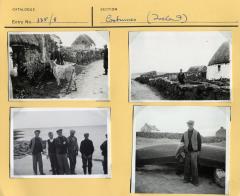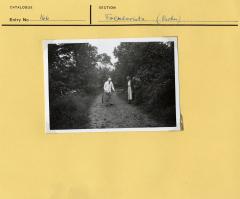
1965.5.1.131-134 Aran Islands, Ireland. Photographs taken by Ingegard Vallin and Ellen Ettlinger 1949

1965.5.1.275 J.F. Parker using a scythe with Ingegard Vallin & Albert Sandklef. Photo by Ettlinger 1948
Find out more about the images on this page
In 1965 Ettlinger decided to give her working catalogue of index cards and mounted photographic prints in 5 purpose-made boxes to the Pitt Rivers Museum. Given that this was nearly 30 years before her death, and at the height of her production of papers and reviews for journals, the decision seems a curious one. Her motivation was sadly not recorded and will always remain a mystery.
The index cards are all the same, a yellow colour, rectangular and quite thick. Onto them she pasted, or more usually affixed using photographic corner attachments, a series of orginal photographic prints (as with the ones shown here, see above for more information), cuttings from periodicals like Country Life (mostly from the 1950s), or postcards. Some of the photographs were taken by Ettlinger herself but others she obtained the prints from friends and professional acquaintances.
On the top of the front of the card she often gave a number and then categorised the image or images into certain categories which are considered in more detail below. On the reverse, or sometimes on the front as well, she pasted a typed piece of paper which repeated the categorisation and gave the accession number. As this number was only assigned when the cards were accessioned by the Pitt Rivers Museum these pasted sheets may post-date the accessioning of the artefacts (though it is uncommon even at this date, for museum professionals to agree a permanent change to an artefact in this way). However it seems clear that the number and the subsequent description of the image are contemporaneous. Sometimes handwritten notes are added to the typed notes as with the example shown. These appear to be by Ettinger herself as they match the handwriting on the front of the cards.
One theory would be that Ettlinger, who lived in Oxford, came into the Museum after the images were accessioned and added the pasted typed information and handwritten notes herself, or else that someone else added the pasted notes from (now lost) information from Ettlinger and Ettlinger then added any missing information. It is possible therefore that the cards themselves were only constructed after Ettlinger's images came to the Museum but this seems unlikely as the original donation refers to the boxes which appear to be the ones that continue to be used:
Accession Book Entry - Mrs E Ettlinger, ... Oxford - 1965.5.1 (1-600) - Collection of photographs, relating mainly to arts, crafts and folk practices in Great Britain, but also including transport, farm life and architecture - Each photo has number & information on it - Contained in 3 small boxes & 2 large - See pocket at end of accession book for index & duplicate with the photographs - [Added Accession Book Entry - ] - One copy in Secretary’s file “Accessions 1965”, one copy in related documents file
My own opinion is that Ettlinger used the information on the front for herself, the numbers which are not accession numbers and the categorisation to arrange them in the boxes, but realised (or was informed by museum staff) that additional documentation was needed for museum artefacts and added the typed pasted information on the reverse.
The card catalogue contains images of people and things from all over Europe, just under half deal with English things or people, there are also a lot of images of Irish places, costume and artefacts (like the ones used to illustrate this page). Many of the English cards deal with church related material and this reflects her interests in churches and folklore. Many of the Irish cards relate to costume and traditional pastimes as well as archaeological sites. She obviously received photographs from many colleagues but the most common collaborators were Ingegärd Vallin (a Swedish folklorist),[1] and Thomas H. Mason [2] and Michael J. Murphy [3] (Irish folklorists). She utilised her network of folklore connections to obtain images that interested her, and it is clear that some were sent to her unsolicited because they knew of her interests.
Find out more about the Categories used by Ettlinger
[1] Ingegärd Vallin was Director at Boras Museum, Sweden from 1940 to 1974 and obviously travelled with Ettlinger in Ireland, she donated a series of photographs of Tissington well dressing to her.
[2] Thomas H. Mason wrote 'The Islands of ireland: their scenery, people, life, and antiquities' Batsford 1938
[3] Michael J. Murphy (1913-1996) Worked as a folklorist in University College, Dublin. See http://www.pgil-eirdata.org/html/ pgil_datasets/authors/m/Murphy,MJ/life.htm